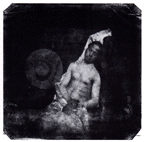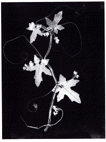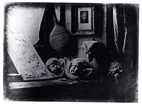| |
 Hippolyte Bayward, Le Noyé
(self-portrait as a drowned man),
18 October 1840, direct positive
print, Société Française de
Photographie, Paris (#24.269)
|
Studies based on
the notion of a clear historical period always rest on
dubious grounds. Attempts at locating beginnings usually
result in foundational stories that have more to do with
our own time's ruminations than with the ideas of those
who contributed to mark a fresh turn in history. It seems
plausible, however, to locate the beginnings of what
could well be the single most influential force to have
shaped contemporary everyday life aesthetics. I am
referring to photography, an artifice whose beginnings
coincide with those of modernity. Such has been the
expansion of photographic technology over the past two
hundred years that today we could be excused for failing
to see it: it's all around us. Geoffrey Batchen¹s Burning
With Desire: The Conception of Photography surveys
the four decades prior to the medium's official birth in
1839. Batchen identifies a "desire to
photograph", which begins to take hold of some
curious minds around the 1790s. The ensuing three decades
were a period of extensive experimentation, which
culminated with photography's official unveiling before
the Parisian elites. Batchen documents this period
carefully, down to the anecdotal detail, making Burning
with Desire an interesting as well as enjoyable read.
Batchen's research shows that the writing of light on
chemically sensitive surfaces did not begin as a mere
French curiosity. Due credit is given to at least twenty
'proto-photographers' in seven countries for setting up
the discursive framework that today allows us to conceive
of photography. Both the timing and the ubiquity of these
experiments suggest that photography was part of a larger
historical unfolding. Batchen presents the early desire
to photograph in the light of Foucault¹s historical
understanding of the epistemological rupture that marked
the transition from the Classical age to modernity.
Although Foucauldian studies of the photographic image
have already been rehearsed by the likes of John Tag and
more recently Jonathan Crary, Batchen remains concerned
about the methodological impasse that such critiques have
inadvertently posed: the project of emptying photography,
as a medium, from any formal quality of its own, has
ended up invalidating the very notion of photography.
Indeed, the prevailing view in Anglo-american postmodern
criticism defines photography as nothing but an
instrument of power. Such an instrumental view rests on
the idealist premise that operations of power somehow
precede photography.
Batchen combines Foucault and Derrida to argue that
photography, like writing, is more than an
inconsequential medium. Photography is, by definition,
the writing of light. It is a paradox, a "message
without a code" in which both nature and culture are
directly implicated in a mutual play of power dynamics.
Batchen advances the notion of "photopower" to
reinvest photography with the value it lost to positivist
aesthetics.
As photography now begins to recede, clearing the way
for the digitisation of communication technologies,
Batchen revisits those early days when the new medium was
still accepted as an unresolved phenomenon. Burning
With Desire shows that the initial questions posed by
the discovery of photography are yet to be resolved. Or
are they? The writing of light keeps playing hide and
seek with reason. This is where one may begin to
appreciate the real breadth of Batchen's project: In
showing that photography is more than an inert instrument
of power, his study may be put to work as a model for a
metacritique of postmodern strategies; as a warning
against the consequences of assuming necessary and
sufficient answers.
Jorge Lopez
1998
©
except images
|
| |

William
Henry Fox Talbot, Botanical
Specimen, c. 1835, photographic
drawing negative, Science and
Society Picture, Science Museum,
London.
|
| |

Louis
Daguerre, Still Life,
1837, daguerreotype, Société
Française de Photographie, Paris.
|
| |
 Jurraien Andriessen, Artist
with
a Camera Obscura, c. 1810,
pen and ink wash drawing,
Koninlkijk Oudheidkundig
Genootschap (Rijksmuseum),
Amsterdam.
|

